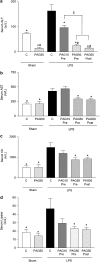Inhibition of endogenous hydrogen sulfide formation reduces the organ injury caused by endotoxemia
- PMID: 16100527
- PMCID: PMC1751176
- DOI: 10.1038/sj.bjp.0706367
Inhibition of endogenous hydrogen sulfide formation reduces the organ injury caused by endotoxemia
Abstract
Hydrogen sulfide (H2S) is a naturally occurring gaseous transmitter, which may play important roles in normal physiology and disease. Here, we investigated the role of H2S in the organ injury caused by severe endotoxemia in the rat. Male Wistar rats were subjected to acute endotoxemia (Escherichia coli lipopolysaccharide (LPS) 6 mg kg(-1) intravenously (i.v.) for 6 h) and treated with vehicle (saline, 1 ml kg(-1) i.v.) or DL-propargylglycine (PAG, 10-100 mg kg(-1) i.v.), an inhibitor of the H2S-synthesizing enzyme cystathionine-gamma-lyase (CSE). PAG was administered either 30 min prior to or 60 min after the induction of endotoxemia. Endotoxemia resulted in circulatory failure (hypotension and tachycardia) and an increase in serum levels of alanine aminotransferase and aspartate aminotransferase (markers for hepatic injury), lipase (indicator of pancreatic injury) and creatine kinase (indicator of neuromuscular injury). In the liver, endotoxemia induced a significant increase in the myeloperoxidase (MPO) activity, and in the expression and activity of the H2S-synthesizing enzymes CSE and cystathionine-beta-synthase. Administration of PAG either prior to or after the injection of LPS dose-dependently reduced the hepatocellular, pancreatic and neuromuscular injury caused by endotoxemia, but not the circulatory failure. Pretreatment of rats with PAG abolished the LPS-induced increase in the MPO activity and in the formation of H2S and in the liver. These findings support the view that an enhanced formation of H2S contributes to the pathophysiology of the organ injury in endotoxemia. We propose that inhibition of H2S synthesis may be a useful therapeutic strategy against the organ injury associated with sepsis and shock.
Figures





References
-
- BAUE A.E. Sepsis, multi-organ dysfunction syndrome (MODS) and multiple organ failure (MOF). Prevention is better than treatment. Minerva Anestesiol. 1999;65:477–480. - PubMed
-
- BAUE A.E.The multiple organ or system failure syndrome Pathophysiology of Shock, Sepsis, and Organ Failure 1993Berlin: Springer Verlag; 1004–1008.ed. Schlag, G. & Redl, H. pp.
-
- BHATIA M., SALUJA A.K., HOFBAUER B., FROSSARD J.L., LEE H.S., CASTAGLIUOLO I., WANG C.C., GERARD N., POTHOULAKIS C., STEER M.L. Role of substance P and the neurokinin 1 receptor in acute pancreatitis and pancreatitis-associated lung injury. Proc. Natl. Acad. Sci. U.S.A. 1998;95:4760–4765. - PMC - PubMed
Publication types
MeSH terms
Substances
LinkOut - more resources
Full Text Sources
Other Literature Sources
Research Materials
Miscellaneous

